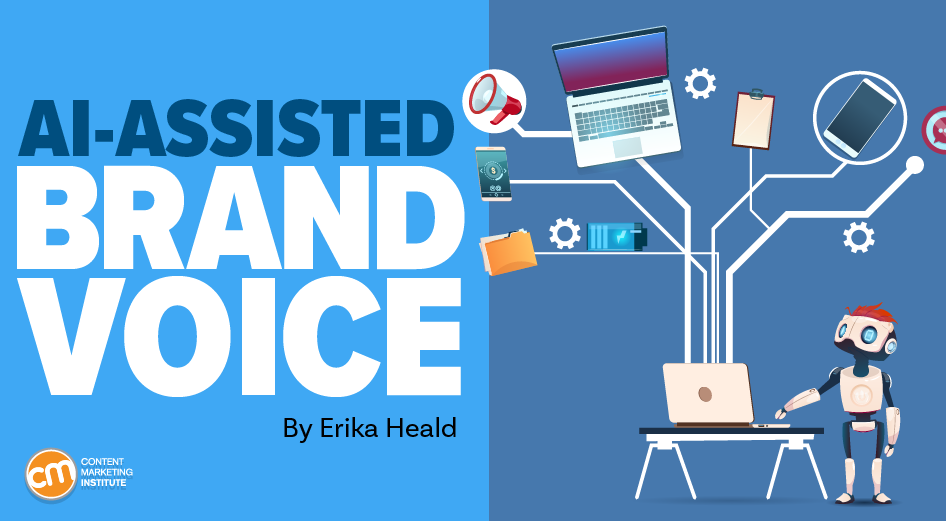
A cacophony of brand voices hums in discord across your content spectrum.
Getting them to sing together presents a challenge for even the most experienced content marketing professional.
But a consistent brand voice is possible. With an assist from artificial intelligence, you can create a solution that brings harmony to your brand’s content.
Let’s delve into how you can use AI to define and reinforce your brand voice with a standardized framework that aligns with your company’s ethos and doesn’t stifle creative expression.
Promise of AI in brand voice consistency
AI’s capacity to analyze vast datasets means it can understand your brand’s voice across different contexts. By feeding the AI tool your brand voice guidelines, do’s and don’ts, successful content, and more, you allow it to enable content creation that aligns with your brand’s voice across the enterprise.
Among the ways AI can help you deliver a more consistent brand voice across every customer touchpoint:
- Document your differentiated brand voice.
- Audit your website to see how brand voice comes across in your content.
- Act as the keeper of the brand voice by reviewing content at scale across all creators and publishers in your organization.
Now, let’s walk through how it can help you do all three of those things.
AI documents your brand voice
AI can analyze your most successful content pieces to understand what works. By identifying patterns in language, tone, and style that resonate with your audience, AI can help replicate these success factors in future content.
I asked GPT-4o to develop a brand voice for my gluten-free blog and create a brand voice chart modeled after an example in my earlier CMI article, 5 Steps to Define Your Brand Voice.
Here’s the prompt:
You are an experienced content marketer, with a specialty in branding and creating a consistent brand voice, and you work for https://ErikasGlutenFreeKitchen.com. You need to define and document your brand voice and how it is reflected in your content.
Define five key brand voice attributes for the site and display them in a simple table with the following columns: voice attribute, attribute definition, do’s, and don’ts.
With this simple prompt and a site full of content that reflects the desired brand voice, the tool generates a solid draft of a brand voice chart:
| Voice Attribute | Attribute Definition | Do’s | Don’ts |
| Personal | Creating a sense of connection and intimacy, as if speaking directly to each individual customer, fostering a personal relationship. | – Use first-person language to address the audience. – Share personal anecdotes and stories related to gluten-free living and cooking. |
– Avoid generic or impersonal language. – Don’t come across as overly familiar or intrusive. |
| Informative | Providing valuable and relevant information about gluten-free living, recipes, and products, positioning the brand as a trusted source of knowledge. | – Offer in-depth insights into gluten-free ingredients, cooking techniques, and health benefits. – Share news and updates from the gluten-free community. |
– Don’t provide inaccurate or misleading information. – Avoid overwhelming the audience with overly technical terminology or complex recipes. |
| Creative | Demonstrating innovation, creativity, and originality in content creation, inspiring excitement, and engagement among the audience. | – Experiment with unique recipes and cooking methods. – Showcase visually appealing and creative content, such as videos and infographics. |
– Don’t stick to conventional or predictable content formats. – Avoid plagiarism or copying content from other sources. |
| Supportive | Offering guidance, assistance, and encouragement to individuals navigating gluten-free diets, fostering a supportive community. | – Respond empathetically to reader inquiries and concerns. – Provide practical tips and advice for managing gluten-free lifestyle challenges. |
– Don’t dismiss or invalidate readers’ experiences or difficulties. – Avoid being condescending or patronizing in tone. |
| Authentic | Maintaining honesty, transparency, and authenticity in all communication, building trust and credibility with the audience. | – Share genuine experiences, successes, and challenges related to gluten-free living. – Be transparent about product recommendations and affiliations. |
– Don’t fabricate stories or mislead the audience. – Avoid endorsing products or practices that conflict with the brand’s values or ethics. |
While the chart doesn’t match exactly what I would have created, it’s pretty good.
When I manually create a brand voice chart, I typically include three or four specific do’s and don’ts to make each voice element concrete. Also, my voice attributes are written as a statement from the brand, and I use an active verb at the start. For example, I would have defined “authentic” as “Maintain honesty, transparency, and ethical standards in all content and communications.” But overall, it hits the mark.
It took a minute — literally — to get a solid starting point. If your brand voice is in transition, replace the URL in my prompt example with text examples or links to owned content that represents what your brand aims to embody.
AI can audit your brand voice in action
Now, you have an objective summary of the voice on your website or whatever content you shared. Compare this AI-created draft to your manually created brand voice documentation and ask three questions:
- How similar are the two charts?
- Did AI detect any traits that conflict with the desired brand voice?
- Do some traits feel more like a specific competitor’s voice or the industry overall?
To compare your voice with a competitor or the industry, follow a similar process outlined in the first prompt using their content.
For example, I asked ChatGPT to compare the brand voice on my gluten-free blog to my consulting business site. The prompt was:
You are an experienced content marketer, with a specialty in branding and creating a consistent brand voice, and you work for https://erikasglutenfreekitchen.com. You need to compare and document the difference between your brand voice and how it is reflected in your content with the brand voice of content that appears on https://erikaheald.com.
Using the brand voice chart, you drafted above, please explain how erikaheald.com is similar to or differs from this voice chart.”
Here’s an excerpt from the output:
1. Friendly
Erika’s Gluten-Free Kitchen:
Do’s: Use inclusive language, greet readers warmly, share personal stories.
Don’ts: Use formal or distant language, ignore reader engagement.
Erika Heald’s Blog:
Similarity: Both blogs use a friendly and approachable tone. Erika Heald’s blog also aims to create a personal connection with its readers by sharing personal stories and experiences.
Difference: Erika Heald’s blog, while friendly, tends to have a more professional tone given its focus on marketing and career advice, which can sometimes come across as less warm compared to the very homey and conversational style of Erika’s Gluten-Free Kitchen.”
The AI-created comparison is spot on. My business website strives to provide expert content, frequently on complex topics. By its nature, the content isn’t going to feel as homey as the food blog.
Harmonize content across the enterprise
With this AI assistance, every team member — regardless of location or department — can immediately apply brand voice guidelines to their everyday workflow. Unlike a static document people must seek out and use, AI can provide real-time suggestions and adjustments to ensure any piece of content aligns with your brand voice.
To do this, upload your style guide to the library of an AI content creation tool or manually train an AI tool on your brand’s preferences over time. Ideally, you can do both and create an AI-powered content creation buddy that keeps everyone on the team up to date on the latest and greatest campaigns, priority pieces of pillar content to link to, and ever-evolving best practices for your channels.
Given the growth of AI tools for content marketing teams, if a tool doesn’t yet meet your IT specifications and integration requirements, you can likely expect one soon.
By integrating AI into your content creation and communication tools, you can ensure baseline consistency. Whether it’s a blog post crafted in Los Angeles or a marketing email from a team in Barcelona, AI helps maintain a harmonious brand voice.
Realizing the vision
Recently, I shared in a MarketingProfs presentation how to make AI the BFF (best friend forever) of your brand voice. I said a consistent brand voice is akin to a cherry tree in full bloom. Each flower is distinct, yet together, they form an immediately recognizable and uniform entity. With AI, this beautiful harmony is finally within your grasp.
By incorporating AI into your content workflow, you do not replace but amplify human creativity. AI helps you and your team remove uncertainty around brand voice compliance and frees you to focus on innovative and engaging storytelling within the framework of your brand identity.
In my work, I use AI almost every day to keep consistent brand voices. These tools include:
- Grammarly. I run draft content through the paid version of Grammarly, which has reviewed my writing every week for years. It has learned my preferences and desired brand voice and gives feedback on my tone as I write.
- Copy.ai and Writer. I upload my and my clients’ brand style guides and voice charts to these tools. Now, I can point to this documentation and review content for feedback on where the content could be more on-brand.
- Beautiful.ai. Whenever I need to create a new presentation deck, I ask this tool to take my presentation outline and create a draft that reflects my saved style template, provided URLs, and slides in my library.
In adopting AI, you don’t hand over the reins but equip yourself with a powerful ally that ensures your brand’s voice is heard, recognized, and trusted across every touchpoint.
Where do you go from here?
As you start on this AI-enhanced content journey, approach it with a blend of enthusiasm and caution. Success lies in meticulously documenting your brand voice and training your AI tools with precision. Do not treat them as composers but as instruments in a symphony, each playing a part in creating a coherent and captivating brand melody.
In doing so, you ensure a consistent brand voice and open new opportunities for creativity and personalization, making each engagement with your brand a memorable experience.
All tools mentioned in this article were suggested by the author. If you’d like to suggest a tool, share the article on social media with a comment.
HANDPICKED RELATED CONTENT:
Cover image by Joseph Kalinowski/Content Marketing Institute

